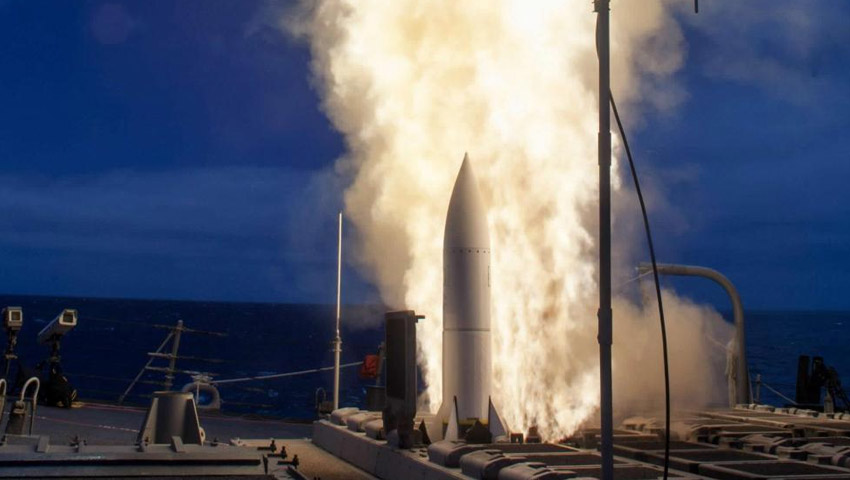Should Australia continue to pursue sovereign long-range missile capability or would Defence be better off purchasing off the shelf?
To continue reading the rest of this article, please log in.
Create free account to get unlimited news articles and more!
In March, the Commonwealth government selected Raytheon Australia and Lockheed Martin Australia as strategic partners for the $1 billion sovereign Guided Weapons and Explosive Ordnance Enterprise (GWEO).
The global prime contractors will be supported by local cooperatives, including the Australian Missile Corporation, the Sovereign Missile Alliance and Aurecon Advisory.
The enterprise ecosystem is expected to support Defence’s inventory of guided weapons and explosive ordnance, while also including:
- manufacturing;
- R&D;
- education and training;
- test and evaluation;
- maintenance and repair;
- storage and distribution; and
- disposal.
However, critics have questioned the efficacy of a sovereign long-range missile program, given resourcing and time constraints, particularly in a deteriorating geopolitical environment.
Such critics have suggested Defence stockpile long-range missile capability, like the Tomahawk or Long-Range Anti-Ship Missile (LRASM), via direct off-the-shelf purchases from foreign suppliers.
This includes the government’s recent $3.5 billion investment in the accelerated delivery of Lockheed Martin-built Joint Air-to-Surface Standoff Missiles (JASSM-ER) and Kongsberg-built Naval Strike Missiles (NSM) by 2024.
But according to Graeme Dunk, head of strategy at Shoal Group, the government’s sovereign long-range missile manufacturing endeavour is key to shoring up the nation’s deterrence in a heightened threat environment.
Dunk stresses the need for an assured supply of long-range munitions in the event of a global production shortage.
“Given that we’re likely to be participating in the same fight as the Tomahawk supplier, it’s difficult to see how we would have suitable options for resupply once our stockpiled weapons had been fired,” he writes.
“After all, the US will need every weapon coming off the production line for its own forces. That means the Tomahawk or LRASM can be the answer only in the short term to provide an immediate capability.”
Dunk goes on to note the limited shelf-life of long-range missiles and the difficulties associated with stockpiling weapons head of a potential conflict.
“Resupply risks at the critical time will be high, and stockpiled missiles have a shelf life measured in years, not decades,” he continues.
“Stockpiling is not the answer. We need to design and build our own land-based, long-range and hypersonic weapons here.”
The Shoal Group executive suggests Defence action the local development of weapons, which “don’t have to be integrated into complex platforms” and don’t require complex maintenance or training regimes.
“Designing and building this type of missile here will provide part of the asymmetric capabilities that Australia needs,” Dunk writes.
“It will contribute to the development of the believable deterrent posture that Australia needs but doesn’t have.
“An extra ship, an extra couple of planes and additional tanks are not going to make any real difference. The ability to manufacture and deploy large numbers of domestically designed hypersonic weapons will.”
Dunk also dismisses claims that designing and building guided weapons would be “long-term, expensive and beyond the capability of the Australian defence industry”.
“Australia’s defence industry has proven itself time and time again as being capable of developing advanced technologies for defence purposes, but the cultural cringe within the Defence Department typically forces these local developments into the loving embrace of the global primes,” he writes.
“The local industry is replete with companies capable of contributing to a domestic effort to build long-range hypersonic missiles: flight vehicle and sensor design and manufacture, propellant technology, command and control systems, integration with the firing platform.”
He acknowledges the time and financial constraints linked to the development of hypersonic missiles, but flags greater risks associated with failing to pursue the capability.
“Not developing these weapons will see us expend large amounts of resources on a finite stockpile that cannot be replenished when we need it to be,” he states.
Dunk concludes: “There’s a popular proverb that says: ‘The best time to plant a tree was 20 years ago. The second-best time is now.’
“It’s time to get cracking.”
Get involved with the discussion and let us know your thoughts on Australia’s future role and position in the Indo-Pacific region and what you would like to see from Australia's political leaders in terms of partisan and bipartisan agenda setting in the comments section below, or get in touch with

 Login
Login







